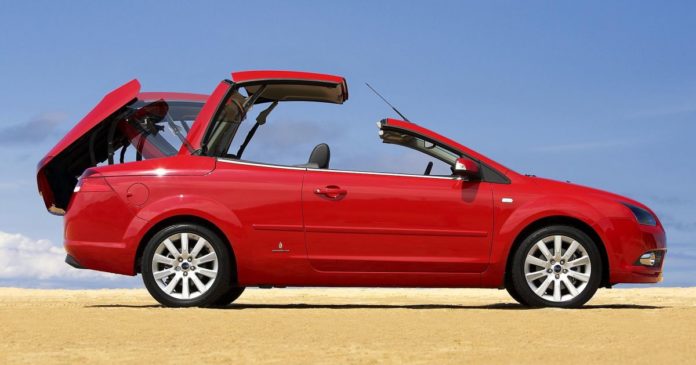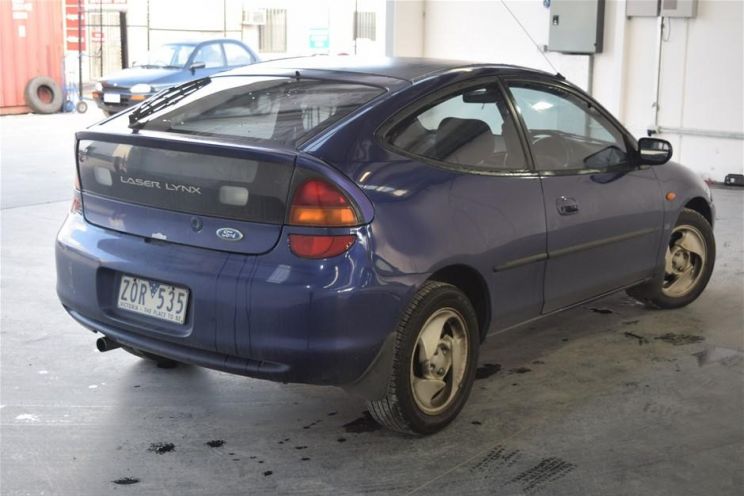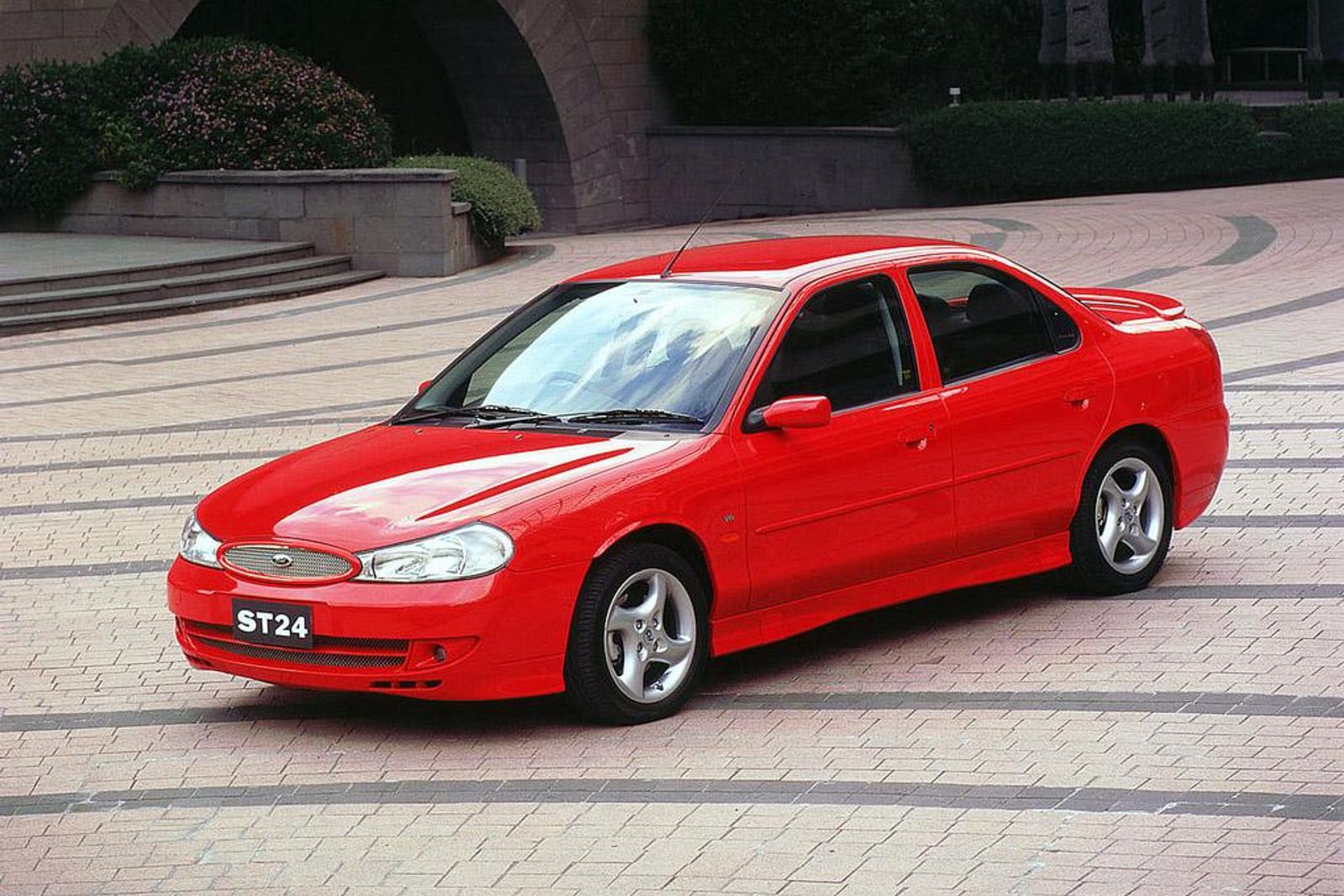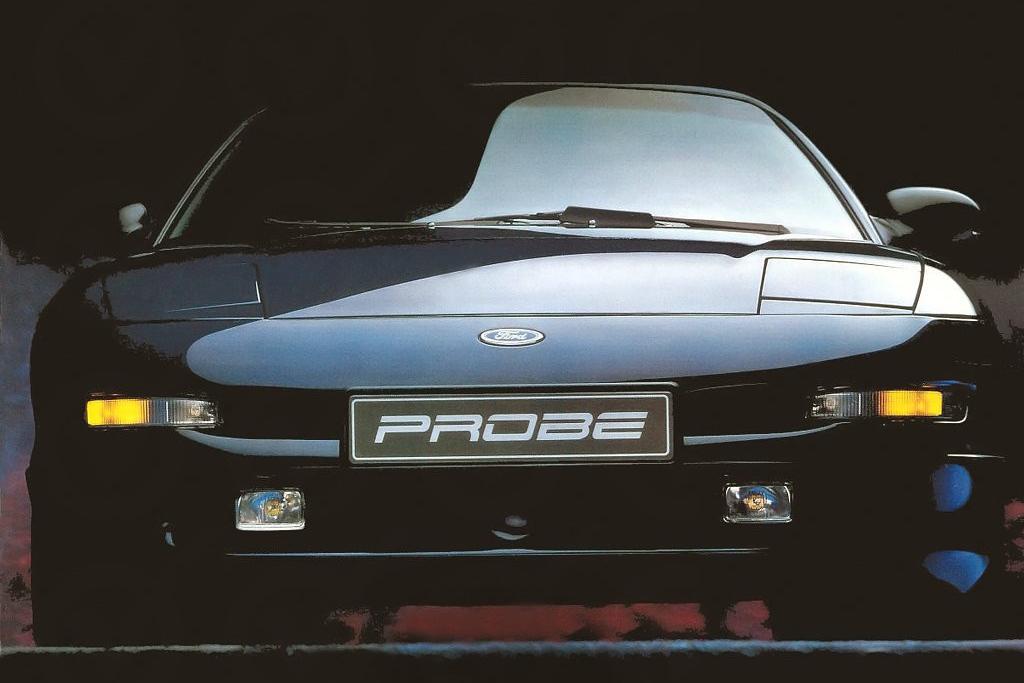Ford Australia recently announced it was discontinuing the slow-selling current-generation Escape after just three years on the market.
It’s part of an exodus of European Fords from the local line-up – while the Puma is sticking around, the Fiesta ST and Focus ST died last year, and the latest generation of non-ST Focus models lasted only a few years.
Ford has therefore left a trail of fairly low-volume, short-lived models in a short space of time, but these are hardly the first in the Blue Oval’s local history. Following on from the last instalment, here are five more.
This article was originally published in 2020. We’re republishing popular content.
1994-96 Ford Laser Lynx
-
Photos courtesy of Grays Online -
In 1994, Ford introduced its first fully imported Laser range to Australia. Still based on the Mazda 323, the KJ range largely consisted of four-door sedan and five-door Liata hatchback models. At the top of the range sat a new, three-door flagship, the Lynx.
It used the same body as the Japanese-market Familia Neo, albeit with a polarising new face with four round headlights.
Past imported flagship Lasers had packed turbocharged power and four-wheel drive but the Laser Lynx, despite its wild styling, was decidedly more mild.
The only engine was a naturally aspirated 1.8-litre four-cylinder producing 92kW of power and 160Nm of torque, mated to a five-speed manual.
That was down 25kW and 46Nm on the TX3 Turbo 4WD that had capped the 1993 range and was the same engine used in the Laser Ghia, which cost around $2000 less in five-door, manual guise.
It justified the expense with its quirky styling and some extra kit, like remote central locking, but Ford had overestimated the demand for a highly-specified three-door hatchback with no sporting pretensions.
The Laser Lynx may have driven well, but so did all the other KJ Lasers. When it came time for the KJ Series II facelift in 1996, the Lynx was quietly shown the door.
2000 Ford Cougar Eibach
The Ford Probe hadn’t managed to topple the class leaders in the sales race despite aggressive styling and excellent Mazda MX-6-based mechanicals. Perhaps that was in part due to its name, which conjured images of dorky-looking spacecraft (or worse).
Though the coupe market was declining, Ford opted to replace the Probe with its new Cougar in 1999. In the US, it was badged as a Mercury but unlike its rear-wheel drive and predominantly V8-powered predecessors, this wasn’t a personal luxury coupe. Instead, it was a Mondeo-based, front-wheel drive (FWD) coupe that would also be sold in Europe.
With a mandatory 2.5-litre V6 engine here and one of the best applications of Ford’s often controversial New Edge design language, not to mention an excellent FWD platform, the Cougar had the recipe for success. Unfortunately, it was met with buyer apathy.
For its second year on the market, Ford introduced the Cougar Eibach, named for the suspension tuners who worked with Ford and Tickford to create this special edition.
For an extra $5200 you got a 20mm lower ride height, beefier tyres, and retuned springs and shocks. The Cougar was also dressed up with an aggressive body kit with a prominent bonnet scoop. Just 100 were built.
While numerous special editions were offered in the American market, the Eibach would be the only local offering. After its production run ended, the Cougar continued on for another couple of years and received an attractive facelift for 2001.
It’s clear the Cougar wasn’t a resounding success in any of its main markets – the once Capri coupe-adoring British populace largely ignored it and it was axed there in 2001, while 2002 was the final year for it in Australia, Europe, and the USA. Just 1276 Cougars were sold here.
2012-13 Ford Kuga TE
The TE Kuga was introduced in February 2012 and was replaced by a next-generation model just 14 months later, making this one of the shortest-lived models on this list.
Offered in two variants, the Kuga served as a placeholder after Ford discontinued the dated Escape in 2011. Both variants packed a turbocharged 2.5-litre five-cylinder engine borrowed from Volvo and also seen in the front-wheel drive Focus XR5 and Mondeo XR5.
In the Kuga, it produced 147kW of power and 320Nm of torque. All-wheel drive was standard, as was a five-speed automatic transmission.
The Kuga had been introduced all the way back in 2008 in Europe, meaning it came here at the very end of its lifecycle. The mandatory 2.5-litre five also meant there were no price-leader models, leading to a base price of $38,990 – a full $10,000 more than the 2011 Escape, not to mention base model rivals.
Mind you, the Kuga was miles ahead of the elderly Taiwanese Escape that had avoided the substantial updates afforded to North American models.
Bringing the TE model over also helped introduce Australian buyers to the Kuga nameplate, in much the same way as Holden had brought the TR Astra over at the end of its lifecycle to help introduce the vastly more popular TS.
In 2012, Ford sold 1107 Kugas, around half what it had shifted of the Escape the year before. That meant it was outsold by everything from the Great Wall X200/X240 to the Jeep Cherokee, Renault Koleos and Suzuki Grand Vitara.
The following Kuga offered a wider range of engines and trim levels, though even it didn’t rocket to the top of the sales charts. That’s why, come mid-cycle enhancement time, Ford rebranded it as the Escape.
2000 Ford Mondeo ST24
While the five-cylinder Mondeo XR5 Turbo was modestly successful for Ford and lasted several years, there was an earlier sporty Mondeo that sunk without a trace.
Ford did a soft reboot of its Mondeo range for 2000, replacing the LX and GLX sedan, hatch and wagon with a new base Verona sedan, mid-range Ghia hatch, and a new performance flagship, the ST24.
Under the bonnet of the ST24 was the same naturally aspirated 2.5-litre V6 used in the mechanically related Cougar coupe, producing 125kW of power and 220Nm of torque.
-
Photos courtesy of Grays Online -
To further drive the fact this was a sports sedan, the only transmission was a five-speed manual. The Mondeo’s US cousin received an even hotter version, with SVT fettling the 2.5-litre to produce 149kW in the SVT Contour.
The writing was on the wall for the Mondeo by this point, however. Sagging sales and the volatility of the mid-sized segment – wedged between increasingly large, comfortable small cars and more familiar large cars – had already led Nissan and Mitsubishi to pull out to focus on their small and large offerings.
And so, despite having only just “relaunched” the Mondeo range, Ford pulled the plug on it in 2000, leaving the hotter ST24 a one-year wonder. Just 266 examples were sold.
2007-09 Ford Focus Coupe Cabriolet
Just about every car company seemed to have a folding metal hardtop convertible in the 2000s, and Ford was no exception. It introduced its Focus Coupe Cabriolet in 2007, the same year Holden’s soft-top Astra Convertible was replaced with the hardtop Astra TwinTop.
The concept seemed great on paper. You seemed to get the best of both worlds with these droptops – you had a convertible, but with all the security and insulation of a coupe once you put the top up. In the Focus, that action took just under 30 seconds.
This body style had its drawbacks, however, chiefly the extra weight and complexity. To help mitigate the latter, Ford designed its first and thus far only droptop Focus to have only a two-piece roof instead of rivals like the Volkswagen Eos, whose roof folded in five segments.
Unfortunately for the Focus, such a roof required an even larger repository in which to store it. Coupe convertibles were often known for being a bit awkward-looking with both the top up and the top down, though some – like the Volvo C70 with which the Focus shared some parts – managed to avoid this fate.
Not so the Focus, which suffered from one of the most ungainly rear ends of any coupe convertible. It might have worn Pininfarina badging but, hey, even the best have off days. The frumpy Focus had to face the comelier Astra convertible, which also had the advantage of Holden having competed in this segment for a few years, to modest success.
Like the Astra TwinTop, the Focus Coupe Cabriolet came in a single, well-specified model. In fact, the Focus was priced identically to its arch-rival – $45,490 for the five-speed manual, $47,490 for the four-speed auto.
Both had naturally aspirated four-cylinder engines but the Focus’ 2.0-litre produced 107kW of power and 185Nm of torque to the Astra 2.2-litre’s 110kW and 210Nm of torque.
The Astra was sprightlier, even though it weighed an extra 150kg more than the 1454kg Focus that was itself around 150kg more than a Focus sedan. Speaking of the sedan, the Focus Coupe Cabriolet shared its wheelbase and yet rear seat room was nothing special.
In its last full year on sale, 2008, Ford sold 487 examples of its droptop Focus to 858 Astra TwinTops; the Volkswagen Eos managed to outsell both, with a surprising 1852 units.
The TwinTop disappeared after 2009 as Holden switched from the Astra to the Cruze for its small car line but the Focus wasn’t able to take advantage of the vacuum, Ford Australia pulling the plug in 2009. All up, Ford sold 984 examples.
The Focus Coupe Cabriolet continued on in other markets until the introduction of the third-generation Focus, which tellingly lacked a convertible.
The history of Ford in Australia has been marked by cars that have been genuinely good as rivals but never as commercially successful – see Cougar, Mondeo, Focus, Fiesta, Probe, Escape, Kuga et al.
Whether that’s a result of Ford prioritising marketing of its volume-selling models (the Falcon before, the Ranger now) or for some other reason, that leaves a long history of Ford models that are decidedly less ubiquitous on our roads than rival Japanese and Korean models.
It also means there are plenty of Fords which may well have disappeared from your memory banks.
Don’t forget to check out the other articles in this series:
What other brands would you like to see us cover in this series? And have you ever owned any of these Fords? Discuss in the comments!
























